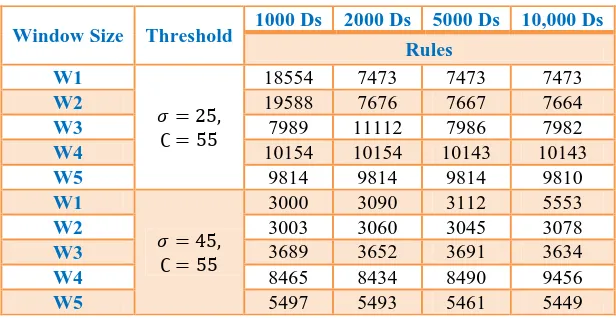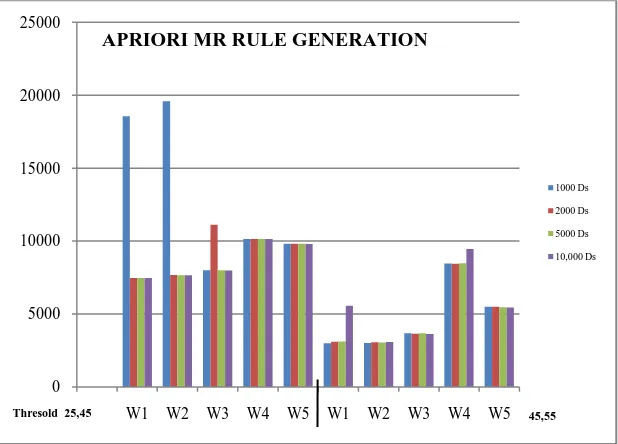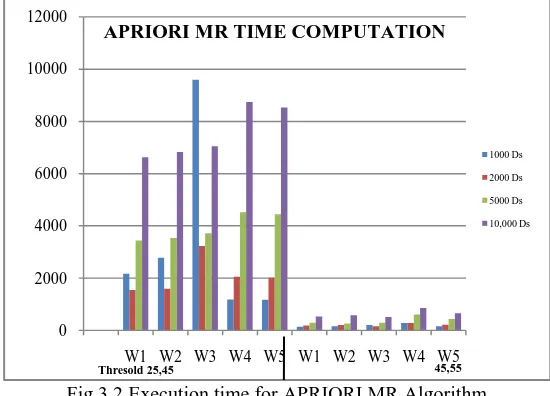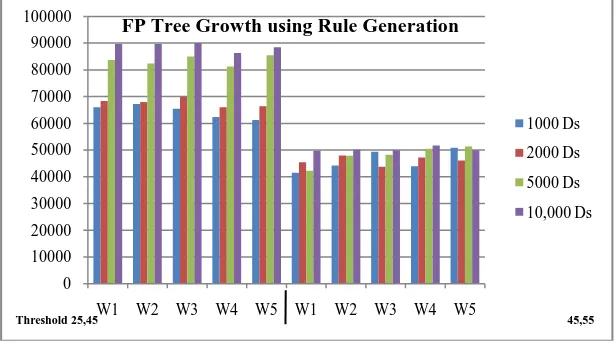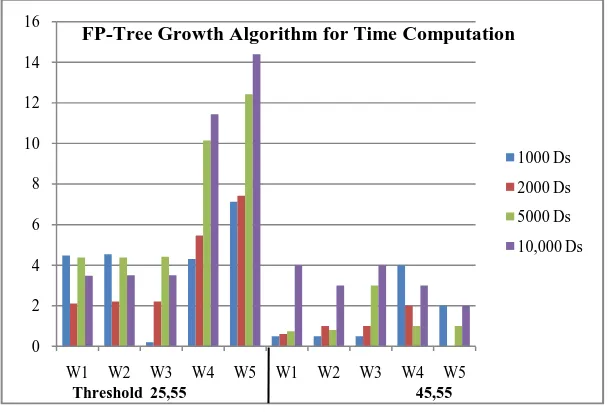ISSN(Online): 2320-9801
ISSN (Print) : 2320-9798
I
nternational
J
ournal of
I
nnovative
R
esearch in
C
omputer
and
C
ommunication
E
ngineering
(An ISO 3297: 2007 Certified Organization) Vol. 3, Issue 9, September 2015
Association Rule Generation in Data Streams
using FP-Growth and APRIORI MR
Algorithms
Dr. S. Vijayarani, R. Prasannalakshmi
Assistant Professor, Dept. of Computer Science, Bharathiar University, Coimbatore, Tamilnadu, India
M.Phil Research Scholar, Dept. of Computer Science, Bharathiar University, Coimbatore, Tamilnadu, India
ABSTRACT: Data stream is used for handling dynamic databases in which data can be arrived continuously, limitless and its size are very large. This situation has created a problem, i.e. to perform the mining process in these database, the existing data mining algorithms are not suitable. In order to perform mining task in data streams there is a need for development of new algorithms and techniques. By using this new algorithms and techniques we can able to perform various data mining tasks, i.e. clustering, classification, frequent pattern mining and association rule mining in data streams. Association rule mining is used to find the association between the data items which are exist in the databases. Even though, the traditional algorithms are not suitable for data streams, this paper concentrated on how to perform association rule generation task in data streams using traditional algorithms in order to find the drawbacks as well as comparing the performance of the traditional algorithms. Frequent Pattern Tree Growth algorithm and APRIORI Map/Reduce algorithms are used for generating association rules in data streams. Performance measures used in this work are execution time and number of association rules generated. From the experimental results we come to know that the performance of FP-Tree Growth algorithm is more efficient than APRIORI Map/Reduce algorithm.
KEY WORDS: Association Rules, FP-Tree Growth Algorithm, APRIORI Map/Reduce Algorithm, Rapid Miner tool, Tanagra tool.
I. INTRODUCTION
The data stream is continuous arrival of data and this data is normally dynamic in nature and its size is very huge. In this situation, it is not possible to perform data mining tasks with the traditional algorithms since those algorithms are suitable for static data bases. Hence, data stream mining needs the development of new algorithms and techniques to perform the data mining tasks. Association rules are described by finding the frequent pattern, links, relationship and the related structures among the data objects in the databases. There are two important steps in association rule mining; first step is to find the frequent data items and second step is to generate association rules from the frequent data items. This work has compared two different types of association rule mining algorithms; they are APRIORI Map/Reduce algorithm and Frequent Pattern Tree Growth algorithm. [15] The main objective of this work is to find the drawbacks of the existing algorithm when it is applied to the data streams and also finding the efficiency of the two existing algorithms APRIORI Map/Reduce and Frequent Pattern Tree Growth.
The paper is organized as follows. Section 2 provides the related works. Proposed methodology and the traditional association rule algorithms are given in Section 3. Section 4 described the experimental results. Conclusion is given in Section 5.
II. RELATED WORK
ISSN(Online): 2320-9801
ISSN (Print) : 2320-9798
I
nternational
J
ournal of
I
nnovative
R
esearch in
C
omputer
and
C
ommunication
E
ngineering
(An ISO 3297: 2007 Certified Organization) Vol. 3, Issue 9, September 2015
Vijayarani S et al., [18]performed a comparative analysis of traditionalassociation rule mining algorithms for data streams. The algorithms are APRIORI, APRIORI PT (Prefix Tree) and APRIORI MR (Map/Reduce). Different sizes of windows and threshold values are used and it concluded that APRIORI MR has produced good results than other algorithms.
Charu C. Aggarwal, [4] presented the detailed information about data streams. He discussed how to relate variant data mining technologies to data streams for supportive and unknown data extraction. He also discussed data stream clustering, data stream classification, association rule mining algorithm in data stream and frequent pattern mining. Kuldeep Malik et al., [13] explained the FP-Growth algorithm and he proposed Enhanced FP-Growth Algorithm. He defined the Enhanced FP- Growth is working without prefix tree and any other complex data structure and he has proved that Enhanced FP-Growth has produced good results than FP-Growth.
III. PROPOSED ALGORITHM
The system architecture of this research work is represented in Figure 1.
Fig 1. System Architecture
A. Dataset
The connect data set is used in this work. This dataset is available in http://fimi.ua.ac.be/data/connect.dat. It has 67,558 instances and 48 attributes. From this 1K, 2K and 5K instances are used in this work. In data streams, we assume that the nonstop arrival of data is partitioned into many windows with permanent size, i.e. W1, W2, W3... Wn. In this work, we have created five windowsW1, W2, W3, W4, W5 with the data set size of 1K, 2K and 5K.
B. Association Rule Generation
In order to generate association rules, two traditional data mining algorithms are used. They are,
APriori MR – Apriori Map/Reduce Algorithm.
FP- Tree - Frequent Pattern Tree Growth Algorithm.
C. APRIORI MR Algorithm
Apriori-Map/Reduce algorithm sprints on equivalent Map/Reduce framework. Candidate generation of Apriori Map/Reduce algorithm is prone (Ck+1) function is to eliminate the non-frequent item set Ck+1 by reducing the non-frequent item sets cannot be a subset of non-frequent item sets. Table 1 corresponds to the APRIORI MR algorithm [12].
Table 1. Pseudo Code for APRIORI Map/Reduce Algorithm
Step 1. Map transaction t in a data supply to all Map nodes Step 2. Each Map node can handle m
Step 3. Now, can use Candidate Map Cm1 = size of 1 is a frequent item set in the node m Step 4. Reduce and compute candidate generation of C1 and L1 with all Cm1
Step 5. C1 = size one of frequent item sets;
Step 6. Calculate the Min_Support = Num/ total items; Step 7. Size 1 of frequent item sets Min_Support is L1 Step 8. Loop begins, For (k=1; Lk!= 0; k++) do
Step 9. Each mapped node m is represent by Lk . Such as, Lmk Step 10.Sort and remove the duplicate item sets
Step 11.Can use, Cm (k+1) = Lk join_sort Lmk;
Data Set Association Rule Generation
FP- Tree Growth Algorithm
Performance Analysis
FP- Tree Growth Algorithm APRIORI Map/Reduce
ISSN(Online): 2320-9801
ISSN (Print) : 2320-9798
I
nternational
J
ournal of
I
nnovative
R
esearch in
C
omputer
and
C
ommunication
E
ngineering
(An ISO 3297: 2007 Certified Organization) Vol. 3, Issue 9, September 2015
Step 12.Reduce methods to use the APRIORI Property to compute the Ck+1 do
Step 13.Each map node m is increment the count of Lm (k+1) candidates. That are supplied by transaction t Step 14.End.
Step 15.Now, Can use reduce method to find the Lk+1 with Lm (k+1) and Min_Support. Step 16.Min_Support of frequent item set generated by size of k+1 is Lk+1.
Step 17.End
Step 18.Return Uk Lk; D. FP Tree Growth Algorithm
FP- Tree Growth used the divide and conquers tactics for creating the frequent item sets. FP-growth is primarily used for mining frequent item sets without candidate generation [13]. It consist of one root tags as null, a set of item prefix sub trees as the children of the root, and a frequent item subtitle table. Every node in the item prefix sub tree consists of three fields: item-name, count and node link where item-name records which item the node characterized; count records the amount of transactions signified by the fraction of path reaching this node, the node links to the next node in the FP- tree. Each item in the subtitle table consists of two fields, item name and head of node link, which positions to the first node in the FP-tree transports the item name. The pseudo code of mining on the FP - tree is portrayed in Table 2.
Table 2. Pseudo Code for FP-Tree Growth Algorithm
Step 1. Input: constructed FP-tree
Step 2. Output: complete set of frequent patterns Step 3. Method: Call FP-growth (FP-tree, null). Step 4. Procedure:
Step 5. FP-growth (Tree, α) Step 6. {
Step 7. if Tree contains a single path P then
Step 8. For each combination do generate patterns β ᶸ α with i. Support = min_sup of nodes in β.
Step 9. Else For each header ai in the header of Tree do { Step 10.Generate pattern β = ai ∪ α with support = ai .support;
Step 11.Construct β.s conditional pattern base and then β.s conditional i. FP-tree Tree β
Step 12.If Tree β = null {}
Step 13.Then call FP-growth (Tree β, β)} Step 14.}
IV. SIMULATION RESULTS
The section describes the experimental results of APRIORI MR and FP-Tree Growth algorithms. The work is implemented on Tanagra tool. Totally, five windows W1, W2, W3, W4 and W5 are used in this research work. There are
Window Size Threshold 1000 Ds 2000 Ds 5000 Ds 10,000 Ds
Rules W1
𝜎 = 25, ∁ = 55
18554 7473 7473 7473
W2 19588 7676 7667 7664
W3 7989 11112 7986 7982
W4 10154 10154 10143 10143
W5 9814 9814 9814 9810
W1
𝜎 = 45, ∁ = 55
3000 3090 3112 5553
W2 3003 3060 3045 3078
W3 3689 3652 3691 3634
W4 8465 8434 8490 9456
ISSN(Online): 2320-9801
ISSN (Print) : 2320-9798
I
nternational
J
ournal of
I
nnovative
R
esearch in
C
omputer
and
C
ommunication
E
ngineering
(An ISO 3297: 2007 Certified Organization) Vol. 3, Issue 9, September 2015
four different sizes of datasets; 1K, 2K, 5K and 10K is tested and their results are obtained. Different threshold values are applied for analyzing the results. The performance factors used in this analysis are number of rules generated and execution time.
Table 3.1 APRIORI MR Algorithm for Rule Generation
Table 3.1 depicted the number of rules generated using APRIORI MR Algorithm. Two different thresholds values 𝜎 = 45, ∁ = 55 are used.
Fig 3.1 Association Rule generation – APRIORI MR Algorithm
Figure 3.1 represented the rule generated by the APRIORI MR algorithm. From this result, it is observed that the minimum threshold value has generated more number of rules.
0 5000 10000 15000 20000 25000
W1 W2 W3 W4 W5 W1 W2 W3 W4 W5
1000 Ds 2000 Ds 5000 Ds
10,000 Ds APRIORI MR RULE GENERATION
45,55 Thresold 25,45
Window Size Threshold 1000 Ds 2000 Ds 5000 Ds 10,000 Ds
Rules W1
𝜎 = 25, ∁ = 55
18554 7473 7473 7473
W2 19588 7676 7667 7664
W3 7989 11112 7986 7982
W4 10154 10154 10143 10143
W5 9814 9814 9814 9810
W1
𝜎 = 45, ∁ = 55
3000 3090 3112 5553
W2 3003 3060 3045 3078
W3 3689 3652 3691 3634
W4 8465 8434 8490 9456
ISSN(Online): 2320-9801
ISSN (Print) : 2320-9798
I
nternational
J
ournal of
I
nnovative
R
esearch in
C
omputer
and
C
ommunication
E
ngineering
(An ISO 3297: 2007 Certified Organization) Vol. 3, Issue 9, September 2015
Table 3.2. Apriori MR Algorithm for Time Computation
Table 3.2 shows the execution time required for APRIORI MR algorithm. Two different thresholds values 𝜎 = 45, ∁ = 55 are used.
Fig 3.2 Execution time for APRIORI MR Algorithm Figure 3.2 represented the execution time taken by the APRIORI MR algorithm.
0 2000 4000 6000 8000 10000 12000
W1 W2 W3 W4 W5 W1 W2 W3 W4 W5 1000 Ds 2000 Ds 5000 Ds
10,000 Ds
Thresold 25,45 45,55
APRIORI MR TIME COMPUTATION Window
Size Threshold
1000 Ds
2000 Ds
5000 Ds
10,000 Ds
Time(ms)
W1
𝜎 = 25, ∁ = 55
2170 1539 3439 6633
W2 2784 1595 3539 6831
W3 9594 3230 3722 7051
W4 1180 2053 4527 8742
W5 1171 2007 4442 8534
W1
𝜎 = 45, ∁ = 55
140 187 296 531
W2 156 203 265 577
W3 203 156 297 515
W4 281 281 609 850
ISSN(Online): 2320-9801
ISSN (Print) : 2320-9798
I
nternational
J
ournal of
I
nnovative
R
esearch in
C
omputer
and
C
ommunication
E
ngineering
(An ISO 3297: 2007 Certified Organization) Vol. 3, Issue 9, September 2015
Table 3.3 FP- Tree Growth Algorithm for Rule Generation
Table 3.3 shows the number of rule generated using FP-Tree Growth algorithm. Two different thresholds values 𝜎 = 45, ∁ = 55 are used.
Fig 3.3 Association Rule Generation – FP Tree Growth Algorithm
Figure 3.3 illustrated the number of rule generated using FP-Tree Growth algorithm. 0
10000 20000 30000 40000 50000 60000 70000 80000 90000 100000
W1 W2 W3 W4 W5 W1 W2 W3 W4 W5
1000 Ds
2000 Ds
5000 Ds
10,000 Ds FP Tree Growth using Rule Generation
Threshold 25,45 45,55
Window Size Threshold
1000 Ds 2000 Ds 5000 Ds 10,000 Ds
Rules
W1
𝜎 = 25, ∁ = 55
65988 68345 83678 89712
W2 67250 67945 82444 89677
W3 65455 69896 84990 90012
W4 62390 65990 81266 86320
W5 61233 66435 85484 88531
W1
𝜎 = 45, ∁ = 55
41435 45412 42265 49710
W2 44289 47892 47811 50101
W3 49342 43672 48234 49875
W4 43861 47239 50420 51676
ISSN(Online): 2320-9801
ISSN (Print) : 2320-9798
I
nternational
J
ournal of
I
nnovative
R
esearch in
C
omputer
and
C
ommunication
E
ngineering
(An ISO 3297: 2007 Certified Organization) Vol. 3, Issue 9, September 2015
Table 3.4 FP-Tree Growth Algorithm for Time Computation
Table 3.4 depicted the execution time required for FP-Tree Growth algorithm. Two different thresholds values 𝜎 = 45, ∁ = 55 are used.
Fig 3.4 Execution Time for FP Tree Growth Algorithm
Figure 3.4 shows the execution time for FP-Tree Growth algorithm.
V. CONCLUSION AND FUTURE WORK
This research work has compared the traditional association rule mining algorithms for generating association rules in data streams. Traditional association rule mining algorithm was experimented very less number of rules generation and execution time is very high. So, we compared with a new proposed algorithm like as FP Growth and APRIORI MR Algorithm. From the experimental results, it is observed that the performance of FP-Tree Growth algorithm is efficient than APRIORI MR Algorithm. In future work, new algorithms are to be developed in order to reduce the number of rules and execution time.
0 2 4 6 8 10 12 14 16
W1 W2 W3 W4 W5 W1 W2 W3 W4 W5
1000 Ds
2000 Ds
5000 Ds
10,000 Ds
Threshold 25,55 45,55
FP-Tree Growth Algorithm for Time Computation
Window Size Threshold 1000 Ds 2000 Ds 5000 Ds 10,000 Ds
Time (ms)
W1
𝜎 = 25, ∁ = 55
1448 1210 1310 1348
W2 1454 1221 1437 1340
W3 1455 1221 1441 1359
W4 1440 1446 1515 1567
W5 1337 1474 1243 1440
W1
𝜎 = 45, ∁ = 55
905 917 912 949
W2 915 917 918 944
W3 917 914 934 955
W4 921 919 946 967
ISSN(Online): 2320-9801
ISSN (Print) : 2320-9798
I
nternational
J
ournal of
I
nnovative
R
esearch in
C
omputer
and
C
ommunication
E
ngineering
(An ISO 3297: 2007 Certified Organization) Vol. 3, Issue 9, September 2015
REFERENCES
1. Aggarwal, C (2003). A Framework for Diagnosing Changes in Evolving Data Streams. ACM SIGMOD Conference.
2. Agrawal, R. and Srikant, R. Fast Algorithms for Mining Association rules. Proc. 20th VLDB conference, Santiago, Chile, 1994.
3. A. Savasere, E. Omiecinski, and S.B. Navathe, “An efficient algorithm for mining association rules in large databases,” Intl. Conf. on Very
Large Databases, pp. 432–444, 1995.
4. Charu C. Aggarwal “Data Stream Models and algorithms”-Data stream book 2009, Springer.
5. Christian Hidber. Online Association rule mining. SIGMOD ’99 Philadelphia, PA. ACM 1-58113-084-8/99/05, 1999.
6. Charanjeet Kaur, Association Rule Mining using Apriori Algorithm: A Survey ISSN: 2278 – 1323 International Journal of Advanced Research
in Computer Engineering & Technology (IJARCET) Volume 2, Issue 6, June 2013.
7. “Data mining techniques “by Arun k Pujari.
8. “Data Streams: An Overview and Scientific Applications” Charu C. Aggarwal.
9. “Data Mining: Introductory and Advanced Topics” Margaret H. Dunham.
10. Frequent item set mining data set repository, http:// fimi.cshelsinki.fi/data/ \
11. Han, J., Kamber, M.: “Data Mining Concepts and Techniques”, Morgan Kaufmann Publishers, 2006.
12. Jongwook Woo, “ Apriori-Map/Reduce Algorithm “ International Organization for Scientific Research, 2012.
13. Kuldeep Malik, Neeraj Raheja and Puneet Garg, “Enhanced FP- Growth Algorithm” IJCEM International Journal of Computational
Engineering & Management, Vol. 12, April 2011 ISSN (Online): 2230-7893, www.IJCEM.org IJCEM www.ijcem.org. 14. “Mining frequent patterns across multiple data streams” Jing Guo, Peng Zhang, Jianlong Tan and Li Guo, 2011.
15. Nan Jiang and Le Gruenwald, “Research Issues in Data Stream Association Rule Mining”- SIGMOD Record, Vol. 35, No. 1, Mar. 2006.
16. Rakesh Agrawal, Ramakrishnan Srikant; Fast Algorithms for Mining Association Rules; Int'l Conf. On Very Large Databases; September
1994.
17. S. Vijayarani, P. Sathya, “ Mining Frequent Item Sets over Data Streams using Éclat Algorithm”, International Conference on Research Trends
in Computer Technologies (ICRTCT - 2013) Proceedings published in International Journal of Computer Applications® (IJCA) (0975 – 8887) 27.
18. S. Vijayarani, R. Prasannalakshmi, “Association Rule Generation in Data Streams Using Apriori Algorithms”, International Journal of
Engineering Research And Management (IJERM) ISSN: 2349- 2058, Volume-01, Issue-09, December 2014.
BIOGRAPHY
Dr. S. Vijayarani, MCA., M.Phil, Ph.D is working as Assistant Professor in the School of Computer Science and Engineering, Bharathiar University, Coimbatore. Her fields of research interest are data mining, privacy and security issues and data streams. She has published papers in the international journals and presented research papers in international and national conferences.

